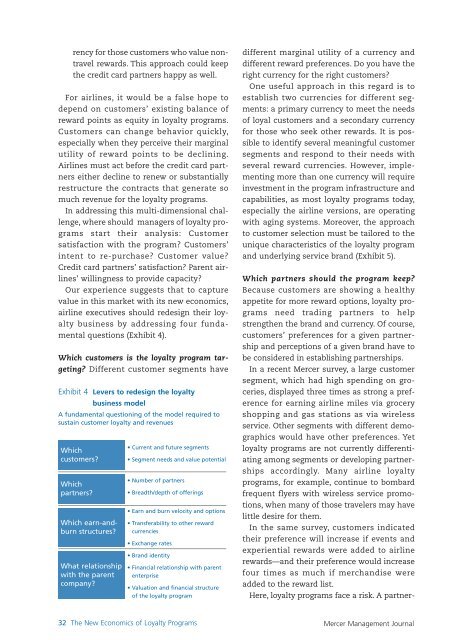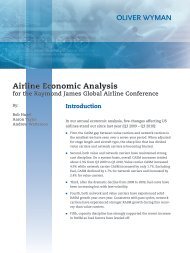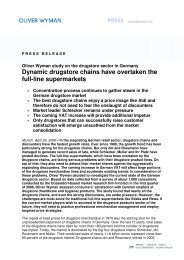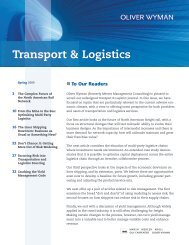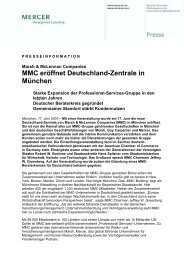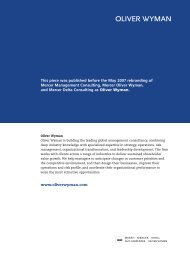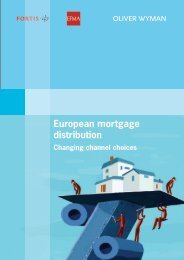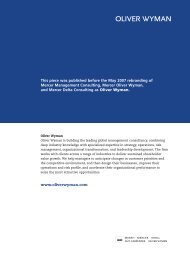The New Economics of Loyalty Programs Customers ... - Oliver Wyman
The New Economics of Loyalty Programs Customers ... - Oliver Wyman
The New Economics of Loyalty Programs Customers ... - Oliver Wyman
Create successful ePaper yourself
Turn your PDF publications into a flip-book with our unique Google optimized e-Paper software.
ency for those customers who value nontravel<br />
rewards. This approach could keep<br />
the credit card partners happy as well.<br />
For airlines, it would be a false hope to<br />
depend on customers’ existing balance <strong>of</strong><br />
reward points as equity in loyalty programs.<br />
<strong>Customers</strong> can change behavior quickly,<br />
especially when they perceive their marginal<br />
utility <strong>of</strong> reward points to be declining.<br />
Airlines must act before the credit card partners<br />
either decline to renew or substantially<br />
restructure the contracts that generate so<br />
much revenue for the loyalty programs.<br />
In addressing this multi-dimensional challenge,<br />
where should managers <strong>of</strong> loyalty programs<br />
start their analysis: Customer<br />
satisfaction with the program? <strong>Customers</strong>’<br />
intent to re-purchase? Customer value?<br />
Credit card partners’ satisfaction? Parent airlines’<br />
willingness to provide capacity?<br />
Our experience suggests that to capture<br />
value in this market with its new economics,<br />
airline executives should redesign their loyalty<br />
business by addressing four fundamental<br />
questions (Exhibit 4).<br />
Which customers is the loyalty program targeting?<br />
Different customer segments have<br />
Exhibit 4 Levers to redesign the loyalty<br />
business model<br />
A fundamental questioning <strong>of</strong> the model required to<br />
sustain customer loyalty and revenues<br />
Which<br />
customers?<br />
Which<br />
partners?<br />
Which earn-andburn<br />
structures?<br />
What relationship<br />
with the parent<br />
company?<br />
Current and future segments<br />
Segment needs and value potential<br />
Number <strong>of</strong> partners<br />
Breadth/depth <strong>of</strong> <strong>of</strong>ferings<br />
Earn and burn velocity and options<br />
Transferability to other reward<br />
currencies<br />
Exchange rates<br />
Brand identity<br />
Financial relationship with parent<br />
enterprise<br />
Valuation and financial structure<br />
<strong>of</strong> the loyalty program<br />
32 <strong>The</strong> <strong>New</strong> <strong>Economics</strong> <strong>of</strong> <strong>Loyalty</strong> <strong>Programs</strong><br />
different marginal utility <strong>of</strong> a currency and<br />
different reward preferences. Do you have the<br />
right currency for the right customers?<br />
One useful approach in this regard is to<br />
establish two currencies for different segments:<br />
a primary currency to meet the needs<br />
<strong>of</strong> loyal customers and a secondary currency<br />
for those who seek other rewards. It is possible<br />
to identify several meaningful customer<br />
segments and respond to their needs with<br />
several reward currencies. However, implementing<br />
more than one currency will require<br />
investment in the program infrastructure and<br />
capabilities, as most loyalty programs today,<br />
especially the airline versions, are operating<br />
with aging systems. Moreover, the approach<br />
to customer selection must be tailored to the<br />
unique characteristics <strong>of</strong> the loyalty program<br />
and underlying service brand (Exhibit 5).<br />
Which partners should the program keep?<br />
Because customers are showing a healthy<br />
appetite for more reward options, loyalty programs<br />
need trading partners to help<br />
strengthen the brand and currency. Of course,<br />
customers’ preferences for a given partnership<br />
and perceptions <strong>of</strong> a given brand have to<br />
be considered in establishing partnerships.<br />
In a recent Mercer survey, a large customer<br />
segment, which had high spending on groceries,<br />
displayed three times as strong a preference<br />
for earning airline miles via grocery<br />
shopping and gas stations as via wireless<br />
service. Other segments with different demographics<br />
would have other preferences. Yet<br />
loyalty programs are not currently differentiating<br />
among segments or developing partnerships<br />
accordingly. Many airline loyalty<br />
programs, for example, continue to bombard<br />
frequent flyers with wireless service promotions,<br />
when many <strong>of</strong> those travelers may have<br />
little desire for them.<br />
In the same survey, customers indicated<br />
their preference will increase if events and<br />
experiential rewards were added to airline<br />
rewards—and their preference would increase<br />
four times as much if merchandise were<br />
added to the reward list.<br />
Here, loyalty programs face a risk. A partner-<br />
Mercer Management Journal


